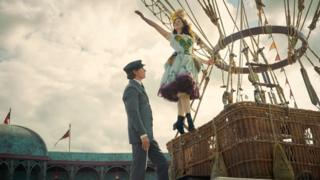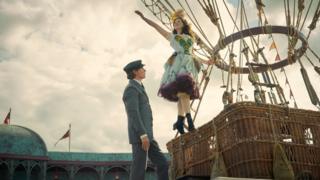The Aeronauts: Facts about fiction in Eddie Redmayne’s new film
Eddie Redmayne’s new movie The Aeronauts is based on real events – but just how accurate is it? …

 Image copyright The Aeronauts
Image copyright The Aeronauts A new film tells the story of a record-breaking balloon flight. It’s based on a real-life ascent, but how accurate is it – and does it matter?
Eddie Redmayne is riding high – whether it’s as a celebrated leading man, or as his character in new film, The Aeronauts.
It’s based on the story of a gas balloon adventure in which scientist James Glaisher and pilot Henry Coxwell took to the skies to further knowledge of meteorology – and in doing so, literally reached new heights, setting a record as they soared.
“Based on” is always a phrase to suggest there may be poetic licence, although Glaisher – played by Redmayne – remains in the movie about the 1862 feat. But it was apparent as soon as casting news broke that pilot Coxwell had effectively blown away.
A fictional character played by Felicity Jones takes his place as Glaisher’s basket partner, and in that sense, history, at least on the silver screen, is rewritten. If, that is, an acutely historical account was ever the film’s purpose.
Either way, it has been clear for a while that the shift to a glamorous, female and widowed daredevil pilot has ruffled some feathers. In the run-up to the film’s release, one of Mr Glaisher’s relatives told the BBC some of the family had been left “horrified” by the changes.
Now, as audiences see the movie, another critic has stepped forward, accusing filmmakers of “airbrushing” history by not making clear the balloon launched from Wolverhampton, a fact that gives the area a slice of the aeronautic past. After all, before NASA launch pads, there was the Midlands city.
But Wolverhampton, do we really have a problem?
According to local historian and writer Jefny Ashcroft, we do.
The name of the vessel – The Mammoth – remains intact. As does its then-record breaking achievement of reaching 37,000ft. But have things otherwise got a bit too Mary Poppins? Filmmakers say the balloon “glides above the streets” of Victorian London. Chim-chim-ch-what?
“I don’t think history should be airbrushed and Wolverhampton should get the credit for being the site of this important event,” Ms Ashcroft said.
“The reason the journey began in Wolverhampton was that they were also concerned that if they had begun in London and gone off course, they could have landed in the river and drowned.
“So picking a location like Wolverhampton was vital for their safety.”
Talking of safety, Glaisher and Coxwell’s ride came to a relatively tidy end in a farmer’s field at Cold Weston, seven-and-a-half miles from Ludlow, according to a relative of Mr Glaisher.
The pair then walked to the railway station only to find there were no trains. So they went to a hotel nearby where the only available dinner, they were disappointed to find, was chops.
Mr Glaisher telegraphed their location that night and the report of the flight was written over breakfast the next day and sent to the newspapers. It was reported in The Times of 11 September 1862 as a leading article.
But the adventure was not without risk. And perhaps while not as romantic as the movie synopsis of “an unlikely pair finding their place in the world” at “the very edge of existence”, things were nevertheless dicey.
That was because they traversed the thin air without the aid of bottled oxygen. The altitude record would, of course, go on to be beaten. But reaching literally dizzying heights without such support is a feat which, the filmmakers say, stands to this day.
According to Ms Ashcroft, though, the record-breaking was simply a happy accident of the quest for meteorological knowledge. And perhaps, the least of the men’s concerns.
“Mr Coxwell’s hands were black with frostbite,” she said, “so he used his teeth to release the gas valve to lower the balloon after Mr Glaisher had passed out.”
And what of the science bit?
“I’ll be interested to see how much science is actually in the film,” said Ali Glaisher, the great-great-great niece of James Glaisher, who explained he had wanted to push the understanding of temperature and humidity.
That said, she does not have too much problem with narrative flights of fancy.
“To replace Mr Coxwell, who was a balloon expert, with an attractive widow character, I can understand why they’ve done it.”
But she had a caveat – her great-great-great uncle was a married man. “I don’t think he’d be going off with any widow,” she said.
All in all, though, she admits to being “sanguine” about the changes. Others are less so. “Some of the family,” she said, “are absolutely horrified.”
So, what do the filmmakers have to say about massaging details?
“[Glashier and Coxwell’s] accomplishments are monumental and while we never intended to create a documentary, we are thankful to them as well as all the other ground-breakers of that time for their bravery and unshakable need for answers,” said director Tom Harper.
“We pulled from so many different flights to create the narrative of the film and hope that those collections of achievements serve as a basis for inspiration to all genders and all ages.”


